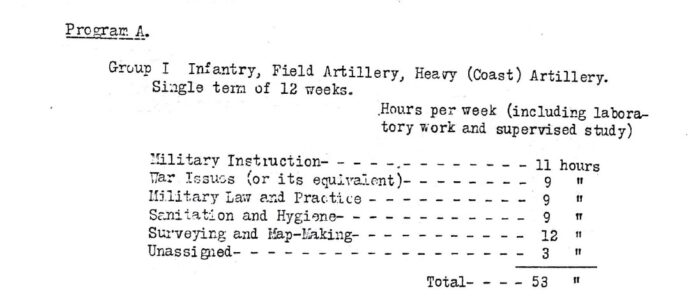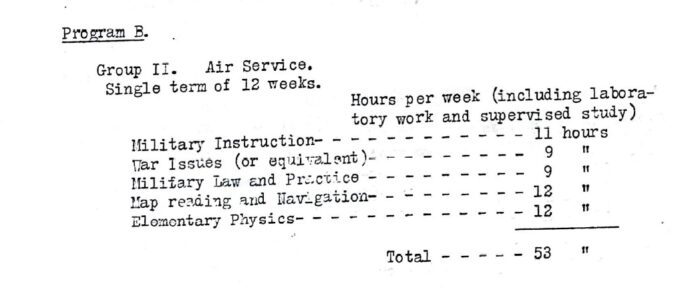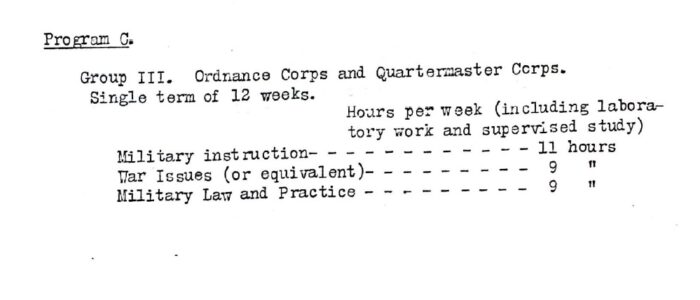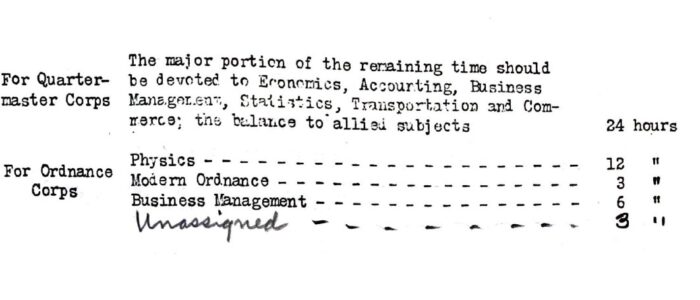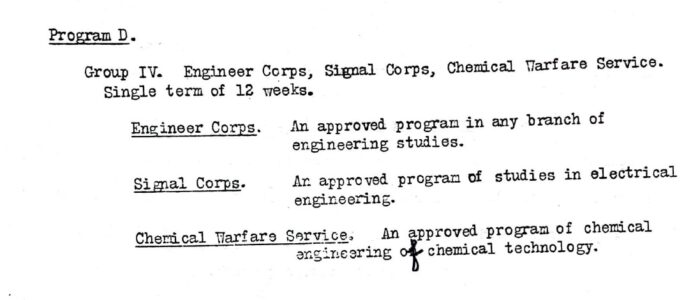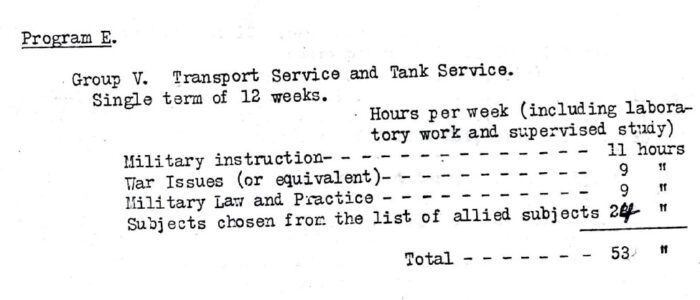Given that twenty year old members of the SATC would only spend three months in the program, the Committee on Education and Special Training (CEST) created several programs of study for these students that were designed to meet the immediate and future needs of the military. These programs were:
- Group I: Infantry, Field Artillery, Heavy (Coast) Artillery (Program A)
- Group II: Air Service (Program B)
- Group III: Ordnance and Quartermaster Service (Program C)
- Group IV: Engineer Corps, Signal Corps and Chemical Warfare Service (Program D)
- Group V: Motor Transport and Truck Service (Program E)1
Course list for each program.2
For Group I: Program A, the CEST recommended SATC students intending to enter the Infantry use their unassigned hours to take either elementary trigonometry (only for students who had not taken plane trigonometry), French, or further study of the War Issues course. For those intending to enter the Field or Heavy (Coast) Artillery, the CEST recommended Mathematics courses.3
Mathematics knowledge was essential for artillerymen to properly calculate the distance and timing of their shells to not hit accidentally hit friendly troops. Familiarity with plane trigonometry was required so officers could properly understand and create maps. Additionally, knowing French would be helpful, since the majority of the fighting on the Western Front took place in French speaking countries and American units often worked in close conjunction with French units.
For Group III: Program C, the CEST issued a Special Bulletin detailing examples for Civil, Mechanical, and Electrical Engineering Programs. The CEST did not expect all SATC institutions offering Engineering training to strictly adhere to the programs in the bulletin, but issued them as guidelines for institutions to modify their current Engineering programs. The bulletin outlined eight terms of instruction, covering four years of military and academic training for SATC students.4 This extended course program indicates that the War Department was anticipating that the war would continue.
War Department Special Bulletin on Programs in Engineering5
Once the twenty year old SATC members had completed their one term of study, they were to be evaluated and rated on several factors including intelligence (measured by their academic performance), their ability to command men, physique, business ability, character, and honor.6 After their evaluation, these men were to be sent to their next assignment, which could be an Central Officers’ Training School, Non-Commissioned Officers Training School, cantonment as a private, or specialty training schools for further specialized technical education.7
For eighteen and nineteen year old SATC members, the CEST did not have set programs. Rather, these students would all take the War Issues Course for 9 hours per week, military instruction for 11 hours, and the other 33 hours would be academic classes chosen from a list that the CEST called Allied Subjects. However, the CEST ordered that during one term, SATC students preparing for a specific program should take the courses listed in that program. So, an eighteen year old SATC student preparing to go into the Air Service would take War Issues, Military Law and Practice, Map Reading and Navigation, Elementary Physics, and military instruction during one of his three terms in the program.8
Notes:
- Memo from the Committee on Education and Special Training to Colleges having units (Collegiate Sections) of the Student Army Training Corps dated September 18, 1918, 4-6, Box 3, Folder 8, Records of the Dean of the College, Theodorick Pryor Campbell, RG 11/1, Special Collections and University Archives, Virginia Tech, Blacksburg, VA.
- Memo from the Committee on Education and Special Training to Colleges having units (Collegiate Sections) of the Student Army Training Corps dated September 18, 1918, 4-6, Box 3, Folder 8, Records of the Dean of the College, Theodorick Pryor Campbell, RG 11/1, Special Collections and University Archives, Virginia Tech, Blacksburg, VA.
- Memo from the Committee on Education and Special Training to Colleges having units (Collegiate Sections) of the Student Army Training Corps dated September 18, 1918, 5, Box 3, Folder 8, Records of the Dean of the College, Theodorick Pryor Campbell, RG 11/1, Special Collections and University Archives, Virginia Tech, Blacksburg, VA.
- War Department Special Bulletin on Programs in Engineering dated September 19, 1918, Box 3, Folder 8, Records of the Dean of the College, Theodorick Pryor Campbell, RG 11/1, Special Collections and University Archives, Virginia Tech, Blacksburg, VA.
- War Department Special Bulletin on Programs in Engineering dated September 19, 1918, Box 3, Folder 8, Records of the Dean of the College, Theodorick Pryor Campbell, RG 11/1, Special Collections and University Archives, Virginia Tech, Blacksburg, VA.
- Memo from Committee on Education and Special Training to Commanding Officers Students Army Training Corps and Presidents of Students Army Training Corps Institutions dated September 28, 1918, 2, Box 3, Folder 8, Records of the Dean of the College, Theodorick Pryor Campbell, RG 11/1, Special Collections and University Archives, Virginia Tech, Blacksburg, VA.
- Memo from Committee on Educational and Special Training about the Length of Course and Assignment of S.A.T.C. Soldiers dated September 28, 1918, 1-2, Box 3, Folder 8, Records of the Dean of the College, Theodorick Pryor Campbell, RG 11/1, Special Collections and University Archives, Virginia Tech, Blacksburg, VA.
- Memo from the Committee on Education and Special Training to Colleges having units (Collegiate Sections) of the Student Army Training Corps dated September 18, 1918, 7, Box 3, Folder 8, Records of the Dean of the College, Theodorick Pryor Campbell, RG 11/1, Special Collections and University Archives, Virginia Tech, Blacksburg, VA.
